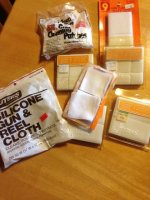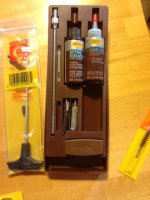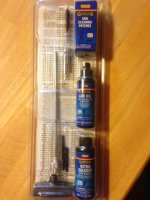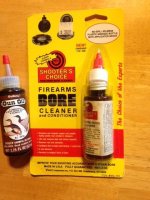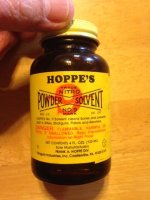I shot my 10-5 snub this Tuesday and haven't cleaned it yet.
I wiped it off with a clean rag with a little bit of Tri-Flow on it and put it up. I was shooting 125 grain Remington +Ps and cheap (relatively speaking) Winchester 130 grain FMJs.
No leading yet, since I haven't run any lead bullets through it.
I fear no lead fouling.
Lead fouling is easier to remove than copper fouling.
A Lewis Lead Remover makes short work of this task.
The only reason I bought the FMJs (accuracy is terrible compared to the HPs), was for function testing new-to-me (used) guns.
That, and to have more reloadable brass.
I cleaned my stainless Taurus 85 (it got nasty inside and out) with some military surplus rifle bore cleaner that smells suspiciously similar to Hoppes #9.
I didn't even break out the rod and brushes.
I used Q-tips and rags and one of the Nylon bristle brushes that looks like a double-ended toothbrush.
No, I didn't give it a full cleaning. Just wanted to get all the powder fouling out.
Didn't even worry about the carbon stains of the front of the cyl.
Used bore solvent/brush/rag on them to get the loose fouling off.
Not worried about the black rings on my stainless cyl.
If I shoot it, it will get stained. I'm not going to waste time scrubbing it off every time, only to have it return every time I shoot it.
I used to remove the rings with a lead removal cloth.
Now, I just leave them.
BTW, I lube them with Tri-Flow Lube normally, because I have more of it.
Alternatively, I'll lube with Ballistol, BreakFree LP, FP10, Tetra Gun, or plain mineral oil, depending on what's close at hand.
I also use 2 versions of Ed's Red for cleaning.
One I made at home using the regular formula.
The other is what I call "field expedient Ed's Red".
"What is that?" you say?
I'm glad you asked.
Field expedient Ed's Red is a version I made at work, using leftovers.
I originally made it as a quicker penetrating oil for rusty parts.
I use my leftovers, IE, partial containers of Dexron 3, carburetor cleaner, brake cleaner, and rust penetrant.
I mix them in the Dexron bottle, until I get the consistency of bore solvent.
Works great, so far.
And, it doesn't cost me a dime, since these are leftovers from my job, that have to be disposed of, since I wouldn't otherwise have room for my restock.
Plus, sometimes, the aerosol chemicals will leak out their propellant after their first use.
Then, I'm left with an unpressurized can of liquid brake or carb cleaner or rust penetrant.
Open the bottom of the can with the handy-dandy P51 can opener, and I can pour said chemical into the ATF bottle and make my solvent.
As time goes buy and I lose a little of the solvent from it permeating the plastic bottle, I add a little brake and/or carb cleaner to get it back to the viscosity of Hoppe's #9.
There's more than one way to skin a cat.
Basically, the carb cleaner and brake cleaner contribute and substitute for the acetone/Stoddard Solvent, and the Rust Pen contributes and substitutes for the kerosene.
Of course, the Dexron contributes the Dexron.
It doesn't take long to accumulate enough to make a quart.
I currently have two quarts of it.
And, THAT'S my favorite way to make ER.
Hopefully, I helped someone figure out how to make ER that costs little to nothing, since anyone who does mechanical work usually has partial containers of these chemicals on hand.
Since they're already paid for, and you don't have to spend time, money, or gas going to the store to locate/buy ER components (plus, who needs a gallon of ER, anyway?), you savings can be huge.

